The Trolley Bags Market is estimated to be valued at USD 21.1 billion in 2025 and is projected to reach USD 35.8 billion by 2035, registering a compound annual growth rate (CAGR) of 5.4% over the forecast period.
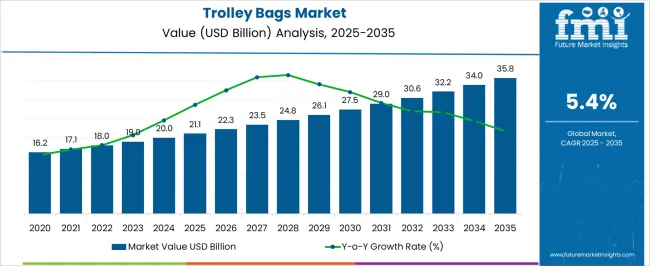
| Metric | Value |
|---|---|
| Trolley Bags Market Estimated Value in (2025 E) | USD 21.1 billion |
| Trolley Bags Market Forecast Value in (2035 F) | USD 35.8 billion |
| Forecast CAGR (2025 to 2035) | 5.4% |
The Trolley Bags market is experiencing steady growth as a result of rising consumer demand for durable, convenient, and travel-friendly luggage solutions. The market landscape is being influenced by increasing domestic and international travel, coupled with a growing preference for versatile and ergonomic bag designs. Innovations in materials and construction methods have allowed manufacturers to provide lightweight, flexible, and aesthetically appealing products, which meet the evolving needs of modern travelers.
Expansion of e-commerce platforms and increasing digital penetration are enhancing accessibility and visibility of premium and mid-range trolley bags, contributing to higher adoption. The market is further supported by consumer inclination towards personalized travel accessories and the rise in business travel in urban centers.
Additionally, investments in retail infrastructure and enhanced distribution networks are facilitating wider market reach As travelers increasingly prioritize convenience, safety, and durability, trolley bags with advanced features and customizable options are positioned to maintain strong demand, driving continued market growth.
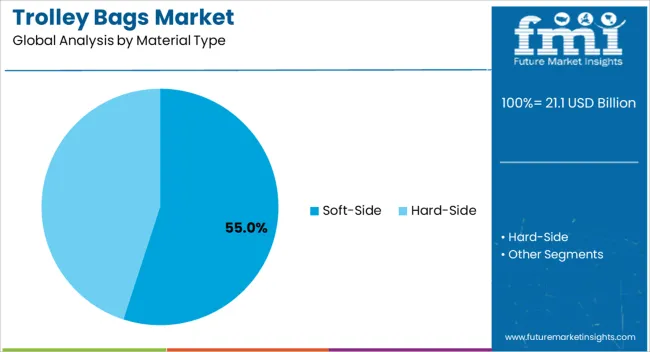
The soft-side material type is projected to account for 55.00% of the Trolley Bags market revenue share in 2025, making it the leading material segment. This dominance has been influenced by the flexibility, light weight, and expandability of soft-side designs, which allow travelers to carry more items without significantly increasing luggage weight. The material’s resistance to impact, ease of storage, and ability to compress for tight spaces have enhanced its appeal among frequent travelers.
Furthermore, soft-side trolley bags are compatible with various design innovations, including multiple compartments, integrated organizational features, and water-resistant coatings. Adoption has been accelerated by consumer preference for luggage that combines durability with portability, making soft-side bags suitable for urban commuting, short trips, and long-haul travel.
The growth of online retail channels has also facilitated wider distribution of soft-side bags, supporting accessibility across demographics These factors collectively reinforce the segment’s leading position and are expected to sustain its growth trajectory in the coming years.
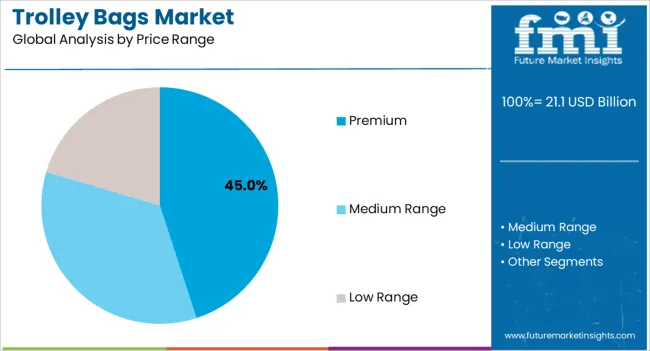
The premium price range segment is estimated to hold 45.00% of the overall market revenue in 2025, emerging as the leading pricing category. This trend is driven by the increasing consumer willingness to invest in high-quality trolley bags that offer superior materials, advanced construction, and enhanced ergonomic features. Premium trolley bags provide long-lasting durability, smooth rolling mechanisms, reinforced handles, and stylish designs, which are highly valued by business travelers and frequent tourists.
The segment has benefited from rising brand awareness, increasing focus on customer experience, and consumer demand for status-driven purchases. Premium bags are also perceived as safer and more reliable for protecting personal belongings, which has contributed to their adoption across both domestic and international travel markets.
Continued growth is expected to be driven by innovations in design, smart luggage integration, and the expansion of lifestyle-oriented retail channels The combination of functional reliability and aspirational appeal solidifies the premium segment as a key revenue contributor in the trolley bags market.
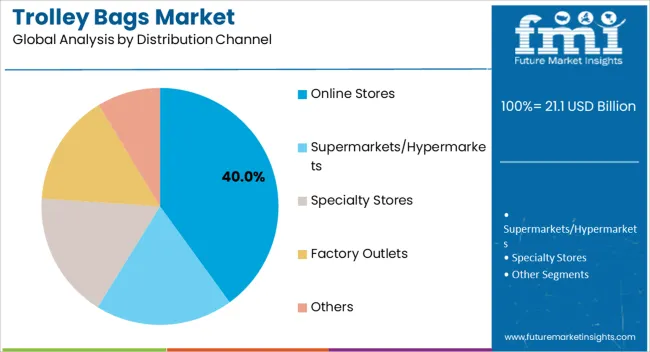
The online stores distribution channel is projected to capture 40.00% of the Trolley Bags market revenue in 2025, making it the leading distribution segment. This growth has been facilitated by the increasing prevalence of e-commerce platforms, which provide convenient access to a wide variety of trolley bag designs and brands. Online channels allow consumers to compare features, prices, and customer reviews, enabling informed purchase decisions while eliminating the need for physical store visits.
The segment has been further strengthened by the rise in digital payment adoption, fast delivery options, and return policies, which enhance consumer confidence and convenience. Additionally, online retailing has enabled niche and premium brands to reach a global audience, expanding market penetration beyond traditional brick-and-mortar stores.
The flexibility of online platforms to showcase new styles, limited editions, and customizable options has contributed to rising adoption among younger, tech-savvy travelers These advantages position the online stores distribution channel as a key growth driver in the trolley bags market, with continued expansion expected in alignment with evolving consumer buying behaviors.
A Surge in Travel and Tourism: Booming travel industry can be referred to as the prime driver bolstering the demand for trolley bags in the global market.
Booming educational opportunities also serve to be a key contributor to the trolley bags market, as students are moving across the globe to pursue different courses, and trolley bags are offering convenience at their fingertips to carry loads of luggage.
Urbanization: Rapid urbanization and changes in lifestyle are creating a demand for innovative products such as polycarbonate luggage bags, hard-side trolley bags, and more.
There is a rising inclination and preference toward adventure, which is acting as a beneficial factor for manufacturing hubs.
Increased Purchasing Power: Middle-class households are witnessing an upsurge in their purchasing power, especially in the developing regions, and is anticipated to create more need for premium and fashionable travel bags, including travel pouches, trolley bags, duffle bags, backpacks, and other.
Besides the factor making a significant contribution to the expansion of the trolley bags market, it is also identified that several factors are going to affect the market in a negative way.
Rise in Unorganized Market Players: Unorganized market players is on the rise; they usually tend to offer products with similar attributes at lower prices to secure expenses on research and development, raw materials of high quality, branding, and advertising. Therefore, the presence of such market players is likely to inhibit the growth of the trolley bags market in the upcoming years.
High Cost of Manufacturing: The procurement of raw materials for manufacturing trolley bags incurs a lot of expense. The high cost associated with the manufacturing unit and high labor charges is going to slow down the pace of advancement in the global trolley bags market.
Market players focusing on technological advancements are expected to boost the demand for smart trolley bags through the introduction of ‘smart luggage.’ This effectuates the rapid growth of the travel and tourism industry across the globe.
A new generation of smart luggage, known as 'EVOA Tech,' can communicate effectively with the owner with the help of the Internet of Things (IoT). Moreover, another smart luggage feature offers a built-in USB port with cables connected to a power bank compartment. These significant updates are remarkably increasing consumer demand and generating profitable opportunities for the market.
High costs associated with overweight luggage at airports are creating lucrative options for market players. Hence, an in-built weighing scale that displays the exact weight of the luggage as soon as the user lifts the bag is an important feature that is expected to considerably surge consumer demand and aid companies in gaining a competitive edge in the market.
The North American region is expected to advance at a steady growth rate during the forecast period. Currently, this region is accountable for 26.0% of the total market share of trolley bags.
The factor contributing to the market size expansion for trolley bags in North America can be owed to the rapid pace of urbanization and increasing disposable income that is encouraging the populace of North America to indulge in more adventurous activities and traveling, simultaneously fueling the demand for trolley bags for smooth luggage carrying purposes.
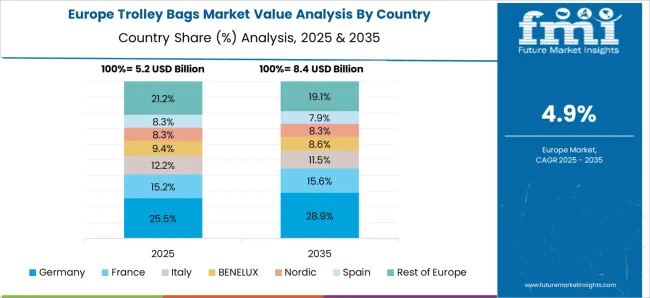
Europe is projected to hold the maxim share of the global trolley bags market. At present, the European regions are cumulatively accountable for 34.0% of the total share of the trolley bags market.
The growth in Europe can be attributed to the presence of the leading market players in this region, who are continually making efforts towards further innovating the product and giving the most durable and unique form of trolley bags to the end-users.
Furthermore, the advancement of technology in the European regions, such as the development of smart luggage with GPS trackers and other facilities in luggage bags, is projected to expand the overall market during the forecast period.
How are the Start-ups Revolutionizing the Trolley Bags Market?
The start-ups in the trolley bags market are evolving their business models with the advent of new technology and the emergence of new exciting trends. They are deploying new interesting themes which are gaining popularity amongst the end users.
Two start-ups to watch for:
| Start-up Name | Away, New York City |
|---|---|
| Year of Foundation | 2020 |
| Total Funding | USD 181 million |
| Description | Away is an internet-first direct-to-consumer luggage brand. The luggage bag has a removable battery to charge electronic devices. The products are manufactured in China and sold via the online platform and offline stores in New York and London. It provides 100 days of free trial and a lifetime warranty on its products. |
| Start-Up Name | Horizn Studios, Berlin (Germany) |
|---|---|
| Year of Foundation | 2020 |
| Total Funding | USD 29 million |
| Description | Horizn Studios designs, produce, and sell travel and personal bags. The brand incorporates various functionalities aimed at the traveler segment into its products, like USB charging, GPS, hard external bag shell, etc. Their flagship product is a smart trolley that is equipped with a smart charger and proximity sensor that warns owners when they are too far from the product. |
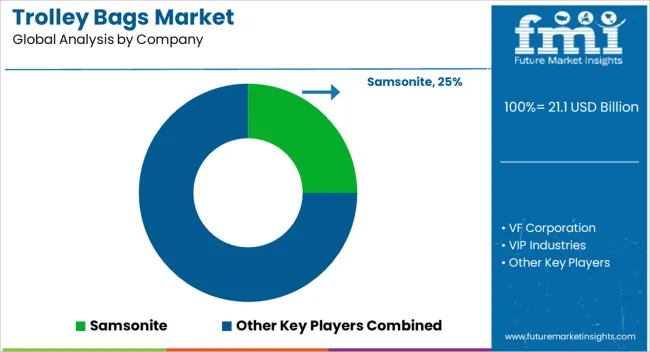
Take of Key Market Players in the Trolley Bags Market
The trolley bag market manufacturers are continuously trying to equip the products with new and advanced features. They are indulging in collaborations and, mergers & acquisitions to facilitate the consumers with premium quality durable products that may lead to more adoption and bolster the market growth of trolley bags.
Top Companies Influencing the Market:
Samsonite: Samsonite is continuously developing innovative solutions with sustainable materials and production processes. This is ensuring their products' durability, extending the product's life, and developing viable end-of-life solutions to divert as many of the products from landfill for as long as possible.
VIP Industries: Asia’s leading organization is focused on organizational transformation towards a professional and streamlined business operation poised for fast-paced profitable growth in the travel bags market.
Delsey: They are a French company which manufactures luggage and travel accessories. They are based in Tremblay-en-France, in the Paris suburbs. As of 2010, they held second place in the global luggage market, behind Samsonite.
Skyway: The brand is devoted to delivering luggage and travel accessories that have universal appeal and are user-friendly. They are committed to quality and continue to manifest their reputation through constant innovation, characterized by the utilization of durable materials to make the customer's travel experience better.
Victorinox: They are a global company with five product categories - Swiss Army Knives, Household & Professional Knives, Watches, Travel Gear, and Fragrances. The Swiss Army Knives, as well as their Travel Gear, are the core products and have a pioneering role in the development of all product categories.
Other Biggies in the Trolley Bags Market are
Some Recent Developments are:
| Attributes | Details |
|---|---|
| Growth Rate | CAGR of 5.4% from 2025 to 2035 |
| Base Year of Estimation | 2025 |
| Historical Data | 2020 to 2025 |
| Forecast Period | 2025 to 2035 |
| Quantitative Units | Revenue in USD million and Volume in Units and F-CAGR from 2025 to 2035 |
| Report Coverage | Revenue Forecast, Volume Forecast, Company Ranking, Competitive Landscape, growth factors, Trends, and Pricing Analysis |
| Key Segments Covered | Material Type, Distribution Channel, Price Range, By Region |
| Regions Covered | North America; Latin America; Europe; East Asia; South Asia; The Middle East & Africa; Oceania |
| Key Countries Profiled | The United States, Canada, Brazil, Mexico, Germany, Italy, France, The United Kingdom, Spain, Russia, China, Japan, India, GCC Countries, Australia |
| Key Companies Profiled | VF Corporation; Samsonite; VIP Industries; Delsey; Briggs & Riley; Rimowa; Travelpro; Tommy Hilfiger; Victorinox; Olympia; Fox Luggage; Skyway; Traveler’s Choice; ACE; Diplomat; EMINENT |
| Customization & Pricing | Available upon Request |
The global trolley bags market is estimated to be valued at USD 21.1 billion in 2025.
The market size for the trolley bags market is projected to reach USD 35.8 billion by 2035.
The trolley bags market is expected to grow at a 5.4% CAGR between 2025 and 2035.
The key product types in trolley bags market are soft-side and hard-side.
In terms of price range, premium segment to command 45.0% share in the trolley bags market in 2025.






Full Research Suite comprises of:
Market outlook & trends analysis
Interviews & case studies
Strategic recommendations
Vendor profiles & capabilities analysis
5-year forecasts
8 regions and 60+ country-level data splits
Market segment data splits
12 months of continuous data updates
DELIVERED AS:
PDF EXCEL ONLINE
Trolley Bus Market
Europe Trolley Bus Market Size and Share Forecast Outlook 2025 to 2035
Market Share Breakdown of Europe Trolley Bus Industry
Platform Trolley Market Growth – Trends & Forecast 2025 to 2035
Resuscitation Trolley Market
Polybags Market Size and Share Forecast Outlook 2025 to 2035
Net Bags Market
VCI Bags Market
Sandbags Market
Leno Bags Market Size and Share Forecast Outlook 2025 to 2035
Silo bags Market Size and Share Forecast Outlook 2025 to 2035
Food Bags Market Share, Size, and Trend Analysis for 2025 to 2035
Competitive Breakdown of Silo Bag Manufacturers
Paper Bags Market Size and Share Forecast Outlook 2025 to 2035
Jumbo Bags Market Size and Share Forecast Outlook 2025 to 2035
Blood Bags Market Size and Share Forecast Outlook 2025 to 2035
Craft Bags Market Growth, Trends, Forecast 2025 to 2035
Market Share Breakdown of Craft Bags Manufacturers
Competitive Breakdown of Paper Bags Providers
Market Share Analysis of Jumbo Bags & Key Players

Thank you!
You will receive an email from our Business Development Manager. Please be sure to check your SPAM/JUNK folder too.
Chat With
MaRIA